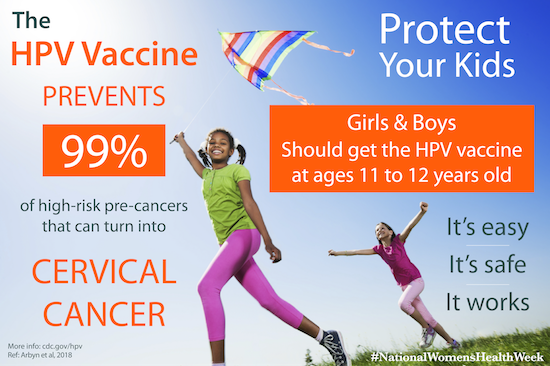By Hank Dart
An important new report further confirms that the HPV vaccine is both safe and extremely effective at preventing cervical pre-cancers that could develop into cervical cancer.
 The report, published Wednesday in the Cochrane Library, reviewed the results of 26 HPV vaccine clinical trials that included over 73,000 girls and women ages 15 – 45 followed for between six months and eight years.
The report, published Wednesday in the Cochrane Library, reviewed the results of 26 HPV vaccine clinical trials that included over 73,000 girls and women ages 15 – 45 followed for between six months and eight years.
Human papillomavirus (HPV) is a common sexually transmitted infection, with up to half or more of adults — men and women — getting infected at some point in their lives. Most of these infections clear up on their own. Some, however, can persist. And if they are of a high-risk type of HPV, they can increase the risk of certain cancers — particularly cervical cancer. Around 70 percent of cervical cancers are linked to HPV16 and HPV18. This new review assessed the potential benefits and risks of HPV vaccines that target these two high-risk types.
The researchers found the HPV vaccine to be very effective at preventing cervical pre-cancers — abnormal changes in cervical cells that can develop into cancer.
In females aged 15 – 25 who did not have a high-risk HPV infection at the beginning of the study, those who received the HPV vaccine had a 99% lower risk of developing HPV16/18-linked cervical pre-cancer (CIN2+) compared to those who did not receive the vaccine (see figure). And even when including those who may have had an HPV infection at the beginning of the study, those who were vaccinated had a 54 percent lower risk of HPV16/18-linked cervical pre-cancer (CIN2+) than those were weren’t.
The researchers also found no difference in rates of serious side effects between those who were vaccinated and those who weren’t. But they also noted that more extensive data are likely needed to fully explore any impact on such rare health events.
Our very first post in Cancer News in Context way back in 2003 was on the potential benefits of the, then new, HPV vaccine – “A Shot in the Arm for Cancer Prevention.” Now in 2018, this new report in the Cochrane Library demonstrates further the true prevention benefits of the vaccine.
In a prepared statement, Dr. Jo Morrison, Consultant in Gynaecological Oncology at the Musgrove Park Hospital in the United Kingdom, said:
“These data show that immunizing against HPV infection protects against cervical pre-cancer, and it is very likely that this will reduce cervical cancer rates in the future.”
Yet, rates of vaccination in the United States lag.
Current guidelines recommend a 2-dose series of the vaccine for both boys and girls at age 11 or 12. In 2016, however, only 44 percent of boys and 55 percent of girls ages 13-17 had had 2 or more doses. Rates of other childhood vaccinations, by comparison, are often around 90 percent or higher.
To bring rates of HPV vaccination up, we need to effectively communicate to parents the importance of the vaccine and its demonstrated safety, train physicians to recommend it, and implement policies that promote and sustain its use.
Compared to many other steps to lower cancer risk, HPV vaccination is relatively quick and simple. And it potential benefits are huge. To realize these benefits, we just need more shots in the arm.


